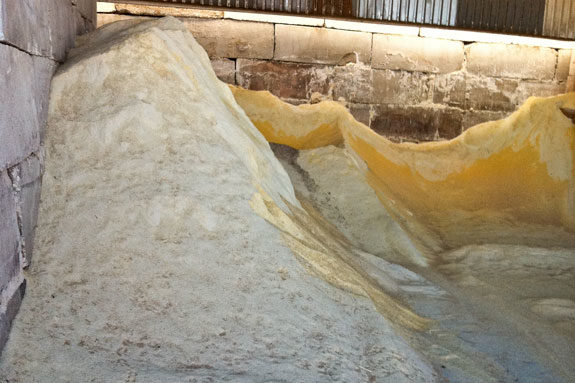Finding a system that works is a top priority when it comes to running a dairy operation, but even more essential to running a financially successful operation. This was the case for Chad Turner, a dairy producer in Nevada who found himself and his dairy in a unique situation that was contributing to a financial burden when it came to feeding his cows.
A unique situation
“Here in Nevada, we don’t have any facility, any mills that would process corn and roll it,” says Turner. “We were having to buy corn from California, which would cost us about $30 a ton.”
Turner, owner of Desert Hills Dairy in Yerington, Nevada, had always kept a close eye on the different expenses on his dairy. The high-dollar items were those associated with his feeding expense, yet one stood out more than others – corn.
Because of the geographic location of the dairy, Turner had to pay more for his corn products than many dairymen across the country.
“We’re kind of in a unique situation because there aren’t very many dairies around so there’s not a big enough need for the grain to where a mill would come in,” says Turner.
Turner was purchasing 14 semi loads of flaked corn a week from California and bringing it to his dairy. This meant paying the freight costs to transport the corn, a factor that added up quickly.
“It’s location, location, location,” says Jason Brixey, a nutritionist from Pine Creek Nutrition Service based out of Turlock, California. “Chad has a lot of hurdles because he is out there in Nevada and he doesn’t get the service that his competition – other dairymen – are getting.”

Weighing the options
Turner worked with Brixey to explore several options and find a solution that would cut down the freight costs the dairy was paying. The two main options that were considered were constructing a flaking facility or purchasing a mill to grind whole corn.
Although freight costs were expensive, Turner explains that he was not only paying for the corn itself, but he was also paying for the moisture inside of the flaked corn that was produced during the flaking process.
“An economic advantage of ground corn is that it is going to be 90-92 percent dry matter, so it’s really dry,” says Brixey. “Flaked corn, however, can be anywhere from 85.5 to 88 percent dry matter.”
Turner was basically paying to truck the corn and the extra water to his dairy.
“Once you take that water out of the equation, you’re talking big money,” says Brixey. “Especially for a herd his size that’s feeding over 10 loads a week.”
While debating between a flaking facility and a corn mill, they laid out what the processing costs would be for each. The expensive processing costs for a flaking facility would have only added to the cost of the facility itself.
The cost of construction of the facility would have amounted to four times the cost of buying a corn mill. Turner explains that there was not enough volume of corn that needed to be flaked to justify the costs that it would bring to his dairy.
Brixey points out that the process of flaking corn is more time-consuming and much more expensive because water has to be heated until it becomes steam, increasing the utility costs the dairy would have to pay. The corn then has to be rolled and steamed until it reaches a certain temperature and then is re-cooled.
“Steam flaking in general is an energy-intensive process and it’s also more of an art form,” Turner says.
The main difference between flaked and ground corn is just the fermentation process it undergoes in the rumen of the cow, Brixey says.
“Basically the absorption rate of ground corn is much higher; it’s utilized faster and fermented more quickly in the rumen, compared to flaked corn,” says Brixey.
Brixey does acknowledge that feeding flaked corn does have its advantages, but those advantages alone would not have been enough to justify the capital expense of constructing a flaking facility.
“There was no question that the ground corn option was the only way to go,” says Brixey.

Going with ground corn
Turner made calls around the country before making his final decision. He spoke with other dairy producers in the Midwest and saw that most were using ground corn in their rations.
“Most of the guys in the Midwest use ground corn and they all have a pretty good proven track record,” Turner says. “Flaked corn is mostly fed in the West.”
In January of this year, Turner came across IFA Roller-Grinder, a company in Iowa that builds roller mills, grinders and magnetic scalpers, among other products. He ended up purchasing a Triple Set Roller Grinder at a cost of $60,000.
After buying the roller-grinder mill, the process for obtaining the corn became simplified and much more cost-effective. Turner says he unloads corn off of the rail cars that pass through near Yerington, cutting the freight out of everything.
He hauls the corn to the dairy, where it is then ground and fed to his cows. Instead of purchasing the flaked corn – the finished product – he buys the whole corn and processes it himself.
“By Chad buying whole corn on the rail, we were able to decrease the total production cost of getting the product into the cow,” says Brixey.
Keeping a close eye on the cows
“We started cautiously, by just putting a little bit of the ground corn in,” Turner says. “We waited to see what the cows would tell us.”
In addition to feeding the corn, Turner makes sure the corn is being fully digested by taking manure samples and screening them to see if there is any pass-through.
“I want the majority of that product to be basically flour,” Brixey says. “The smaller particle size we can get, the better.”

Return on investment
Currently, the grinder processes eight to ten tons of corn per hour. The overall use of the grinder has led to big savings as well. Turner points out that he met the five-month goal that was set in which the product would fully pay itself back.
“It’s about saving pennies here and there,” Turner says.
Turner is now saving $15,000 a month, which stems mostly from cutting out his freight costs for hauling the corn from elsewhere, but also from being able to pay a lower price for the corn itself.
Turner had originally intended to cut the flaked corn in half, which would have meant he would still be hauling in flaked corn from California, just not as much. He says he is down to probably 75 percent ground corn and 25 percent flaked corn now.
“We used to feed about two truckloads a day but are now down to about two to four truckloads of flaked corn a week,” Turner adds.
Brixey points out that the Desert Hills Dairy situation is not the norm across the country, and that the solution created for this dairy would not work for many, but agrees that it was a good decision hands-down. PD
Photo courtesy of Chad Turner.

-
Dario Martinez
- Assistant Editor
- Email Dario Martinez






